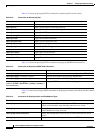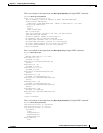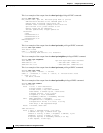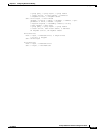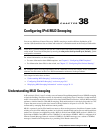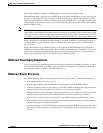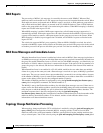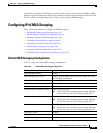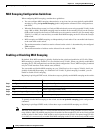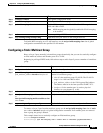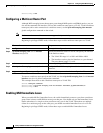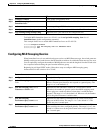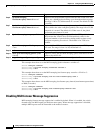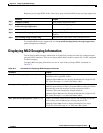
38-4
Catalyst 3560 Switch Software Configuration Guide
OL-8553-06
Chapter 38 Configuring IPv6 MLD Snooping
Understanding MLD Snooping
MLD Reports
The processing of MLDv1 join messages is essentially the same as with IGMPv2. When no IPv6
multicast routers are detected in a VLAN, reports are not processed or forwarded from the switch. When
IPv6 multicast routers are detected and an MLDv1 report is received, an IPv6 multicast group address
and an IPv6 multicast MAC address are entered in the VLAN MLD database. Then all IPv6 multicast
traffic to the group within the VLAN is forwarded using this address. When MLD snooping is disabled,
reports are flooded in the ingress VLAN.
When MLD snooping is enabled, MLD report suppression, called listener message suppression, is
automatically enabled. With report suppression, the switch forwards the first MLDv1 report received by
a group to IPv6 multicast routers; subsequent reports for the group are not sent to the routers. When
MLD snooping is disabled, report suppression is disabled, and all MLDv1 reports are flooded to the
ingress VLAN.
The switch also supports MLDv1 proxy reporting. When an MLDv1 MASQ is received, the switch
responds with MLDv1 reports for the address on which the query arrived if the group exists in the switch
on another port and if the port on which the query arrived is not the last member port for the address.
MLD Done Messages and Immediate-Leave
When the Immediate-Leave feature is enabled and a host sends an MLDv1 Done message (equivalent to
an IGMP leave message), the port on which the Done message was received is immediately deleted from
the group.You enable Immediate-Leave on VLANs and (as with IGMP snooping), you should only use
the feature on VLANs where a single host is connected to the port. If the port was the last member of a
group, the group is also deleted, and the leave information is forwarded to the detected IPv6 multicast
routers.
When Immediate Leave is not enabled in a VLAN (which would be the case when there are multiple
clients for a group on the same port) and a Done message is received on a port, an MASQ is generated
on that port. The user can control when a port membership is removed for an existing address in terms
of the number of MASQs. A port is removed from membership to an address when there are no MLDv1
reports to the address on the port for the configured number of queries.
The number of MASQs generated is configured by using the ipv6 mld snooping last-listener-query
count global configuration command. The default number is 2.
The MASQ is sent to the IPv6 multicast address for which the Done message was sent. If there are no
reports sent to the IPv6 multicast address specified in the MASQ during the switch maximum response
time, the port on which the MASQ was sent is deleted from the IPv6 multicast address database. The
maximum response time is the time configured by using the ipv6 mld snooping
last-listener-query-interval global configuration command. If the deleted port is the last member of the
multicast address, the multicast address is also deleted, and the switch sends the address leave
information to all detected multicast routers.
Topology Change Notification Processing
When topology change notification (TCN) solicitation is enabled by using the ipv6 mld snooping tcn
query solicit global configuration command, MLDv1 snooping sets the VLAN to flood all IPv6
multicast traffic with a configured number of MLDv1 queries before it begins sending multicast data
only to selected ports. You set this value by using the ipv6 mld snooping tcn flood query count global



